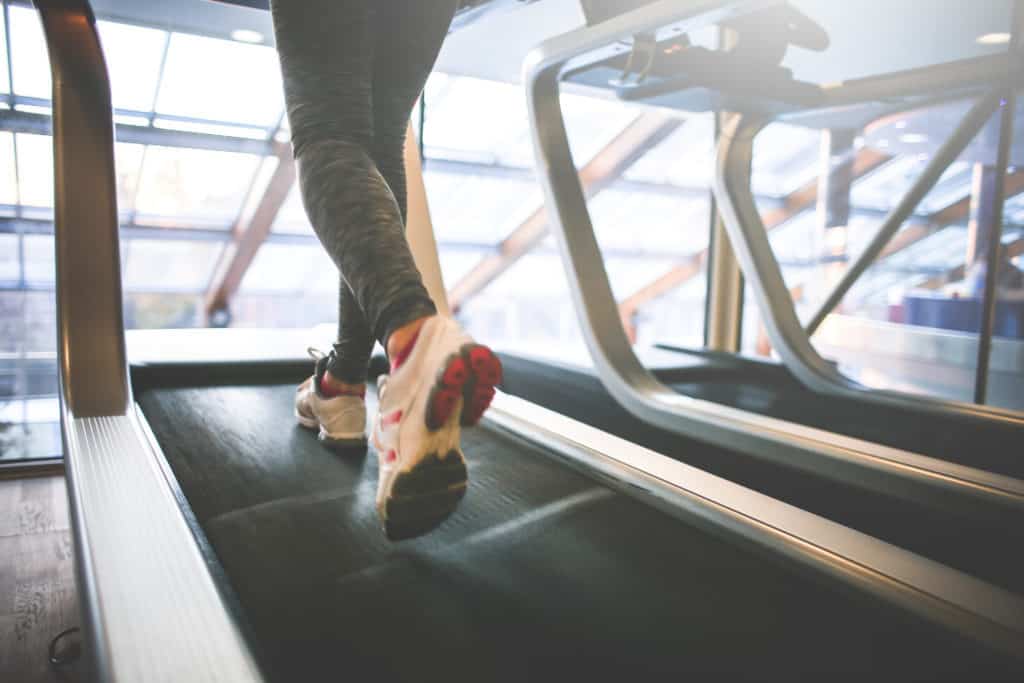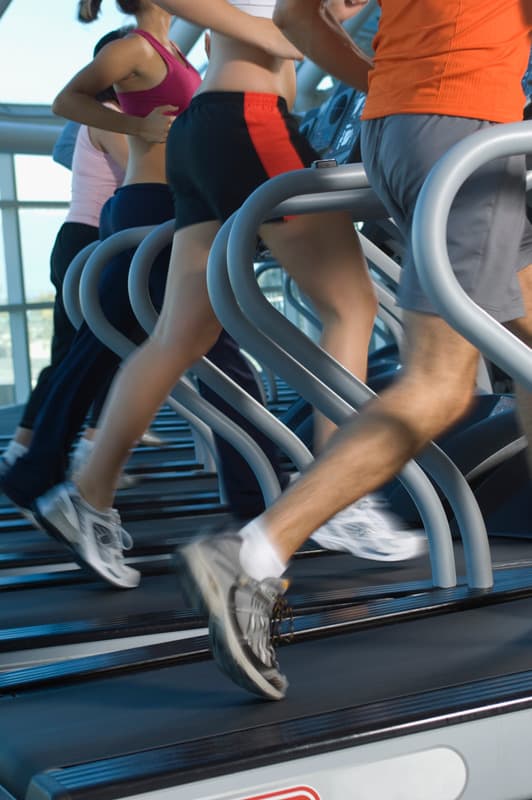Marathon runners are usually divided into two camps when it comes to treadmills. Some fall into the “can’t live without it” category while others avoid it at all costs. Where most of them agree, however, is that outdoor running is a necessary component in marathon training. But, what if taking your runs outdoors just isn’t really possible? Or, perhaps you just feel most comfortable on your treadmill and would choose it over running outside. Whether you’re planning to do some, most or even all of your marathon training on your treadmill, it’s important to know the advantages and disadvantages it will give to prepare you for an outdoor marathon.
So, can I train for a marathon on a treadmill? Yes, almost everyone utilizes the treadmill at some point during their marathon training. Even doing over half of your training runs on a treadmill can work. However, even though a person could train entirely on a treadmill, it would not be my recommendation.
Obviously, your race is going to be outside. And there are elements not easily replicated when you are running on a treadmill indoors. With that said, there are advantages to running on a treadmill (and we have some recommendations). When it means the difference between getting your run in or otherwise skipping it, it’s a necessary tool. There has to balance though, and let’s be honest…who really wants to run upwards of 20 miles on a treadmill anyway? Definitely not me. Knowing what that balance looks like and how to incorporate it into your marathon training will set you up for success.
Advantages of Treadmill Marathon Training
Let me start by saying as a mom with 3 young children, my treadmill is something I rely on heavily. In 2017, I (along with my husband) began training for my first marathon in ten years. All we had was a crappy hand-me-down treadmill that rattled when you ran on it, but I was still so thankful for it. The bulk of my training was done in the summer, so my children were not in anytype of school at that time. I worked from home, too, so carving out time to run outside wasn’t always easy. I’d gather up my kids, bring them to the basement, and get my run in all while watching them play.
People have different circumstances for why a treadmill can be so handy during marathon training. Mine is just one example of why they are so readily used nowadays. Whether it’s because you live in an area where the weather isn’t that conducive to outdoor running, or you simply just like binging Netflix while you run, treadmills can be convenient.
Not only are they convenient, but they also have their advantages. Even people who refer to it as the “dreadmill” and try to skip it altogether could get some advantageous use out of a few treadmill workouts here and there.
When we’re training for a marathon we all have different goals. But whether it’s to finish, PR or qualify for Boston, we all want to do our very best. Treadmills, as boring as they may seem to some, can help many accomplish those goals.
Hills

Being from Colorado, I actually don’t have any problem finding plenty of hills to run on right outside my front door. But for those hailing from a place that’s as flat as far as the eyes can see, getting in a hill workout can be tough. Hill training is an integral part of marathon training, some even call it “speedwork in disguise.” Even if your planned race is completely flat or downhill, training on hills will make you faster and stronger. How does a treadmill fit in? Well, most treadmills go up to a minimum of a 12% incline with many going up to 15%. That is far more than you need to get in a decent hill workout every week or 2. Even if you’re not doing a “hill workout” per se, even bumping that treadmill up to 2-3% while you run can really work to your advantage when you’d otherwise be running on flat ground.
Speedwork
Though I use my treadmill a lot, I actually prefer to do my main speedwork outside. This might be because I usually incorporate it into my mid-long run each week (9-10 miles) and really don’t like to run any more than 7 miles on the treadmill (simply because I get bored). However, if you are someone who doesn’t want to head to a track nor be checking your watch every 800 meters, the treadmill can be very helpful in this area. Not only that, but once you have a goal pace set, it’s as simple as pushing the equivalent speed button on the treadmill and not stopping at that speed until you’re supposed to. Having your speed regulated for you can be very, very nice.
Even though I don’t do my main speed workout on the treadmill, what I do love to do are strides. These are short bursts of 15-30 seconds and can help you increase speed over the course of your training. Since most of my shorter, easy runs are done on the treadmill, strides fit in well, too.
Easier on Joints
Runners who have a difficult time running on cement or asphalt can often do much better when utilizing a treadmill. This is due to the cushioning and flat surface that a treadmill provides. The shock placed on the knee especially can make running on concrete downright painful for people already experiencing knee problems, as noted in this article. Not to mention people like me who are closing in on 40 and just feeling all those little aches and pains just a little bit more than in the past. In this way, the treadmill can be forgiving on the body. With as much running as you’ll do during your marathon training, taking some days to run on the treadmill and gives those uncomfortable joints a break can help you in the long run.
Check out my article, “Best Running Surfaces: The Verdict Might Surprise You” to see the affects different running surfaces have on the body.
Mix it Up
When you’re in the thick of marathon training, it can get monotonous. Especially if you run the same trail for every long run, run on the same track for all your speedwork, run with the same music…you get the idea. There are lots of ways to mix it up and as boring as some people think it is, utilizing the treadmill to break up the monotony a bit can actually help you. Even though I have my own treadmill, I like taking my kids to the gym daycare once/week and jumping on the treadmill there. It actually feels different there and I’m motivated by all the people around me working out, too. And when I’m home, I can watch a favorite cooking show with my kids while I hammer out my run. Sometimes just zoning out for your easy runs is a great way to get them accomplished.

Disadvantages of Treadmill Marathon Training
For as many advantages there are to training for your marathon on a treadmill, there are just as many disadvantages. For some people there just isn’t a need for treadmill running, and there isn’t much negative in skipping it altogether. But, since you’re reading this, I’m guessing that’s not you. Most people have to embrace a treadmill run from time to time, and though there isn’t an issue with sprinkling some into your training, it shouldn’t be the only way you train. Since your race isn’t going to be on the treadmill, it just isn’t apples to apples.
Lack of Weather
The truth is, you have no idea what the weather is going to be like on race day. Yes, some areas are going to be milder than others with less chance of unfavorable weather conditions. But, you really can’t predict exactly how it will be. In 2016, my husband ran a marathon in Las Vegas and it was incredibly windy. Nothing could’ve prepared him really. What I can tell you, though, is that all of his outdoor runs with some amount of wind prepared him a heck of a lot more than had he trained on a treadmill most of the time.
Opting for the treadmill to avoid a bit of bad weather (guilty!) is actually doing your training a disservice. Running in poor conditions will get you ready for anything that might come your way. (Of course, if temps are extreme or it’s icy, obviously the treadmill is the safer option.)
Lack of Air Resistance
Ever think it feels easier to run on a treadmill than outside? That’s because it is. Possibly in part because you’re keeping it at a 0% incline, but also because there is no air resistance. Even on a still day, you create wind as you are running and there will always be some air resistance outside. By bumping up the incline to 1-2% you can increase the difficulty to somewhat counteract this missing factor.
Lack of Terrain
Yes, we stated earlier that running on a treadmill is easier on your joints. But even though it can be used to your advantage on days where your legs are extra tired, it’s not what you want to do all the time. In fact, the same study touting the treadmill’s ability to take stress off of your joints found that it can actually be worse on your Achilles tendon, which I wrote about here. So it’s a bit of a Catch-22. Ultimately, if you’re running a road race, you should train on asphalt or cement. If you’re trail running, you’re going to want to take advantage of trails during a good deal of your runs. Matching the training terrain to what it’s going to be like on race day is just common sense. Your body will be much more prepared than what a treadmill can ever offer.
Lack of Mind over Matter

I’m not saying this is true for everyone, but I think there’s something to be said about getting your mind right to be outside for your longer runs. Sure, it’s easy enough to jump on your treadmill and knock out your 6-mile recovery run while you watch TV. In fact, that’s a great way to keep the easy days easy. But, psychologically they feel different. Lung capacity, strength, and endurance are all huge components of marathon training, but so is your ability to believe that you can do it and push yourself beyond limits you never thought possible. Zoning out on the treadmill or that ability to just stop it and get off at any time can waste this essential part of your training.
I’m no psychology expert, but I know how I feel when I run outside. Or what about the pure joy that can come from running? Even when I’m exhausted, being outside in the fresh air motivates me and makes me happy. I also have to figure out how I’m going to get back to my house when I’m 10 miles away, which I wouldn’t have to do on a treadmill. Scientists from Exeter University even agree that physical activity outside has a great effect on mental well-being.
When the Treadmill is All You Have
There probably aren’t a lot of circumstances in which a person couldn’t train for a marathon outside at all. But elite runner Annie Bersagel of Norway is one such person. As she told the New York Times, the freezing weather and long hours of darkness (paired with her full-time job as a lawyer) made it extremely difficult for her to run outdoors. Even though most of us can probably find a way to get outside for most of our runs…even if it means early in the morning or in the evening, the truth is that not everyone can. The weather could be extreme where you’re training, whether that’s on the cold side or the hot, and a treadmill might be all you have. Or maybe you are confined to a ship for a good deal of time, like this runner. Or maybe, you just really love running on the treadmill and don’t want to run outside. Then what?
Unless a treadmill is absolutely the only way you’re going to get your training in, finding a way to get outside is important. With that said, it’s certainly not impossible to train for a marathon solely on a treadmill. I would imagine those first few miles of your marathon race would feel a little wonky (if not the entire thing) but as far as training your aerobic system by running enough mileage, as I outline here, they could probably perform mostly as intended. This would be especially true if you were smart about your training by implementing a variety of workouts, including hills. I have seen runners post on Instagram about doing a 20+ long run on the treadmill due to bad weather, which I admire. I for one hope I never have to experience that myself.
Best Treadmills for Marathon Training
I personally use the NordicTrack x22i Incline Trainer and we’ve had it since mid-2018. What’s great about it is its incline/decline capabilities. It goes up to a 40% incline (that’s so steep you have to hold onto the sidebars or you’ll literally fall backwards) which is far beyond what normal treadmills can go. If you are a trails person, this is perfect for you. Additionally, it goes down to a 6% decline. Very few treadmills have a decline option. If you’re training for downhill marathon, this is great to have (especially if you live in a flat area). We also got a free year of iFit with it, which I absolutely love using.
We were considering the Matrix T50 XIR as well. Our friends had this one so we tried it out. It was so smooth and would clearly be an excellent treadmill for someone logging lots of miles.
I have also heard great things about the Peloton, but it wasn’t out yet when we bought our treadmill. The $4,000 price tag is pretty steep, but if you are able to spend that I’m sure it’s worth it.
Treadmill Use in Marathon Training
Ultimately, the answer to “Can I train for a marathon on a treadmill?” is a very big yes! But how much is going to be different for every runner.
Not everyone is going to be able to run outside when they want to and having a treadmill is helpful. If it’s a matter of skipping the planned run or doing it on the treadmill, definitely choose the latter. Based on the disadvantages of the treadmill, doing at least half of your runs outside will probably maintain a good balance between the two. I personally like doing most of my recovery runs and hill work on the treadmill and getting outside for all of my speed work and long runs. It works for me!
What works for you when using a treadmill? Have you ever trained for a marathon completely on a treadmill? Or even 75%? I’d love to hear about it!







